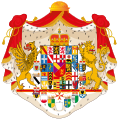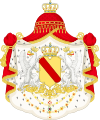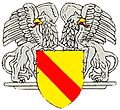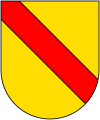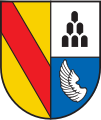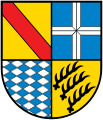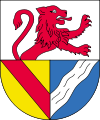Baden's coat of arms
The coat of arms of Baden is on the one hand the coat of arms of the House of Baden , on the other hand the national coat of arms of the territories related to the territory of the house.
The family coat of arms of Baden is a red diagonal bar on a yellow ( heraldic: golden ) background (always from heraldic top right to bottom left). At different times, other components became typical features of Baden's coats of arms, such as the griffin in the coat of arms of the Zähringers or the motto Fidelitas (German: Treue ).
Modern representation of the coat of arms of the House of Zähringen with the color combination gold-red
history
Origins
The Zähringer Berthold I received in 1061 the titles of Duke of Carinthia and Margrave of Verona as a replacement for the Duchy of Swabia that had actually been promised to him . Berthold's son Hermann I , who inherited property around what is now Baden-Baden through his marriage to Judit von Backnang-Sulichgau , received the title of margrave from Berthold and transferred it to his domain.
Hermann's son, Hermann II , referred to himself as Margrave of Baden for the first time . The oldest known coat of arms of the margraves of Baden can be found on a seal of Hermann V , i.e. before 1243. However, it is generally assumed that the inclined beam was already used by Hermann II. The colors gold and red can be traced back to the coat of arms of the Zähringers, who carried a red eagle on gold (sometimes the reverse color sequence is also mentioned). The meaning of the sloping beam is not clear, even though Hugo Gerard Ströhl , citing other coats of arms with sloping beams, assumed that the sloping beam symbolized the right of the margraves of Verona to escort over the Gotthard Pass .
Margraviate of Baden
The Marquis led the coat of arms at the beginning with a crest consisting of buffalo horns with Linde branches . In this representation, the Baden coat of arms appears in the Zurich coat of arms roll around 1330 . The branch line founded by the Margraves of Baden-Hachberg in 1190 , on the other hand, had ibex horns as crests, which became established as ornaments after the reunification of the lines. The griffins as shield holders appeared for the first time on a seal of Margrave Philip I , who - according to tradition - took them over from the Zähringer coat of arms .
Depiction of the coat of arms in the Zurich coat of arms around 1330
Seal of Frederick III. with ibex horns as a crest, ca.1348
Christoph I. on the margrave tablet . The quartered coat of arms shows the Baden sloping beam, the red and silver chessboard of the rear county of Sponheim . Capricorn horns and peacock feathers serve as the crest, the coat of arms is surrounded by the Order of the Golden Fleece .
In 1535 the margraviate was divided into the (from 1556 Protestant) "Ernestine" line of Baden-Durlach and the Catholic "Bernardine" line of Baden-Baden . In the years that followed, both lines carried different coats of arms in which they expressed their rights and legal claims.
Coat of arms of the Baden-Baden line in the alliance coat of arms of Sybilla von Baden at Ettlinger Schloss
Electorate and Grand Duchy
Margrave Karl Friedrich from the Durlach line brought the Baden-Baden and Baden-Durlach lines back together by inheritance in 1771, thereby uniting all Baden branch lines. Due to his good relations with Napoleon , Karl Friedrich was promoted to electoral prince in 1803 and grand duke in 1806 at the main Reich deputation . In May 1803, the electoral dignity was represented by a new large state coat of arms, with a crowned rear-looking griffin as a shield holder. In 1807 the grand ducal coat of arms was issued, which was simplified by Grand Duke Leopold in 1830 and instead of the last 30 coat of arms fields now only showed the main coat of arms with the sloping bar. The coat of arms is held by two rear-looking crowned silver griffins and is covered with a royal crown. Behind it is a purple cloak covered by the same crown with ermine lining. The orders of the House of Baden are shown below the coat of arms: The House Order of Loyalty , the Military Karl Friedrich Order of Merit and the Order of the Zähringer Lion . Under Friedrich I , the order of the Zähringer lion in the coat of arms was replaced by the newly founded order of Berthold the First in 1877 .
Grand ducal coat of arms 1804 depicting the city of Oppenau
Oven plate from Linzgau with the coat of arms of the Grand Duchy of Baden and the year 1828.
Representation of the inclined beam on a boundary stone from 1842 near Fohrenbühl
Republic (1918–1945)
After the November Revolution, the grand ducal house in Baden abdicated and the state became the Republic of Baden . Accordingly, all monarchical regalia were removed from the coat of arms, but the shield and the griffons remained. The new government wanted to emphasize historical continuity and dispensed with republican symbolism. The Baden state coat of arms, which has been in effect since 1830, was only slightly modified. On October 19, 1918, the government commissioned the graphic artist Heinrich Ehehalt to create a design. Its transverse oval shape was unusual for coats of arms. The pattern was produced in the State Majolica Manufactory in Karlsruhe (dimensions - depth: 3 cm, width: 31.8 cm, height: 25.5 cm). By regulation. The Baden coat of arms and the official seals. from January 4, 1921, this draft was declared the official national coat of arms.
Coat of arms with lettering in the town hall of Knittlingen
States of Württemberg-Baden and South Baden
After the Second World War , the Baden area, together with Württemberg and Hohenzollern, was divided into three countries, including South Baden , which under Leo Wohleb vehemently opposed unification with Württemberg and strongly emphasized the delimitation of the states. The state of southern Baden used the Baden shield as its coat of arms, while the coat of arms of Württemberg-Baden represented the symbols of both parts of the country.
Coat of arms of Württemberg-Baden 1945–52
Large coat of arms of South Baden 1945–1952
State of Baden-Württemberg
After the founding of the state of Baden-Württemberg, a controversy arose over the design of the state coat of arms, in which Baden and Württemberg traditionalists ultimately unsuccessfully tried to enforce greater consideration of their well-known coat of arms symbolism compared to the coat of arms with the three striding lions, which refers to the dukes of Swabia. Mostly a split shield with sloping beams and stag poles was required. However, the traditionalists could not prevail. Even today, the Baden coat of arms, standing alone, has a symbolism directed against “Stuttgart” and “the Swabians”, which ties in with the dispute over the creation of the state of Baden-Württemberg and is therefore often found in places where Baden local patriotism is to be represented. Usually a grand ducal coat of arms or that of the Free State of Baden is used here. The coat of arms of Baden can still be found officially in the crown of the large coat of arms of Baden-Württemberg as well as in the coats of arms of a large number of regional authorities in the state. A compromise was that the Württemberg stag and the Baden griffin act as shield holders in the large state coat of arms.
Even outside of Baden-Württemberg, traces of former Baden state affiliation can still be found in some municipal coats of arms. In the coat of arms of the Lower Franconian town of Steinfeld , a golden coat of arms shield with a red sloping bar reminds of the brief Baden sovereignty from 1806 to 1819. In the Palatinate Forest , the Graefensteiner Land belonged to the margraviate in the pre-Napoleonic period , here are inclined beams or griffins in the coats of arms of the communities Rodalben , Clausen , Leimen , Merzalben , Münchweiler an der Rodalb and Petersberg as well as in those of the Verbandsgemeinden Rodalben and Thaleischweiler-Fröschen are represented. The original coat of arms of the House of Baden (see above) is the coat of arms of the Karlsruhe district of Durlach, the capital of the Baden-Durlach line.
City arms of Pforzheim
Coat of arms of the district of Emmendingen
Coat of arms of the district of Breisgau-Hochschwarzwald
Coat of arms of the district of Karlsruhe
Coat of arms of the district of Loerrach
literature
- KGS: On the history of the Baden coat of arms. In: Swiss Archives for Heraldry , Volume XVII (1903), Issue 3, pp. 97-104 in the Internet Archive
- KGS, Rudolf Wackernagel: Addendum: On the history of the Baden coat of arms. In: Swiss Archives for Heraldry , Volume XVIII (1904), Issue 1, pp. 16-17 in the Internet Archive
- Hugo Gerard Ströhl : German coat of arms roll . Julius Hoffmann Publishing House, Stuttgart 1897, p. 31
- Karl von Neuenstein: The coat of arms of the Grand Ducal House of Baden in its historical development combined with genealogical notes , Karlsruhe 1892 digitized
- Franz Zell: History and description of the Baden coat of arms from its creation to its current form . Karlsruhe 1858 ( digitized version )
- Otto Titan von Hefner : The coats of arms of the sovereigns of the German federal states. Nuremberg 1856, pp. 36-38 Google digitized
- Ulrich Friedrich Kopp : About the origin of the coat of arms in general and the Baden region in particular. Freiburg im Breisgau 1831 (published as an appendix by Ernst Julius Leichtlen: Die Zähringer , pp. 95–122 Google digitized version )
- Philipp Jakob Spener : Historia Insignium Illustrium Seu Operis Heraldici Pars Specialis. - Frankfurt am Main, 1717, Lib. II. Cap. IV. § 12, p. 384 digitized version of the Mannheim University Library; Latin
- Otto Titan von Hefner (editor): J. Siebmacher's large and general Wappenbuch , Volume 1, 1856, pp. 36–38 [2] and table 72–78 [3]
- J. Siebmacher's large and general book of arms , volume 7, supplementary volume 1, 1859, plates 31–35 [4] and p. 53 [5]
Web links
- Heraldry of the House of Baden
- Gerhard Graf: The heraldic development of the coat of arms of the House of Baden. pdf, accessed January 10, 2017
- Entry coat of arms of the Republic of Baden on Discover regional studies online - leobw; with color photography
Individual evidence
- ↑ a b Ströhl, p. 31.
- ^ Badisches Landesmuseum Karlsruhe: Baden and Europe 1918 to 2000: Guide through the regional and cultural history department , p. 12
- ↑ see entry coat of arms of the Republic of Baden on discover regional studies online - leobw; with color photography
- ↑ printed in: Badisches Gesetz- und Verordnungsblatt No. 12 of February 28, 1921 [1]
- ↑ There is also a design by Otto Hupp , which was erroneously referred to as the coat of arms of the Republic of Baden.
















